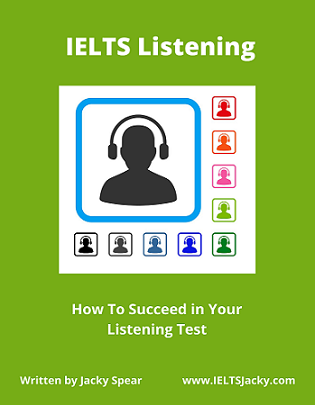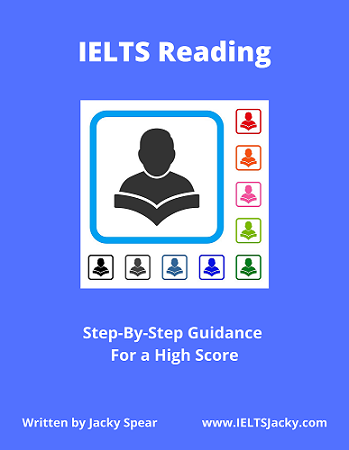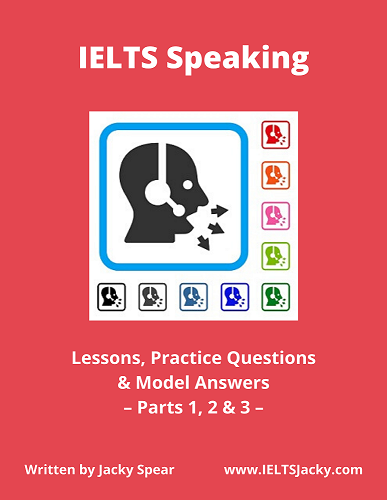IELTS Listening
Form Completion Practice
Form completion questions are one of the easiest types of IELTS Listening questions to answer as long as you know how to recognise and write the vocabulary they typically contain.
You also need a good strategy to follow. I cover all this and many valuable tips in this lesson. The lesson includes:
- Question types
- Sample questions
- Strategy & tips
- Vocabulary
- Practice question
- Answers
Question types
Form completion questions are common in Section 1 of the test and the recording will often be a telephone conversation between two people.
The two most common types of form you’ll see are:
- An application form
- An order or quotation form
Here are examples of both to show you what your question might look like.
Application Form
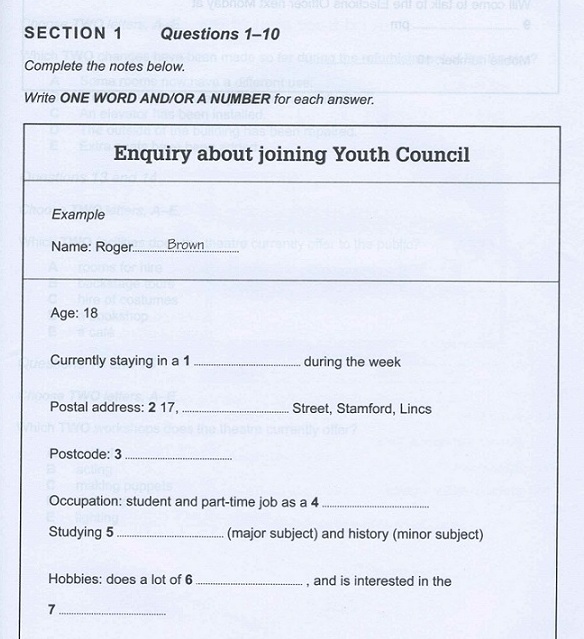
Source: Cambridge English test paper
The recording for this sample question is a telephone conversation between the Youth Council administrator and a young man who wants to apply for election to the Youth Council.
Quotation Form
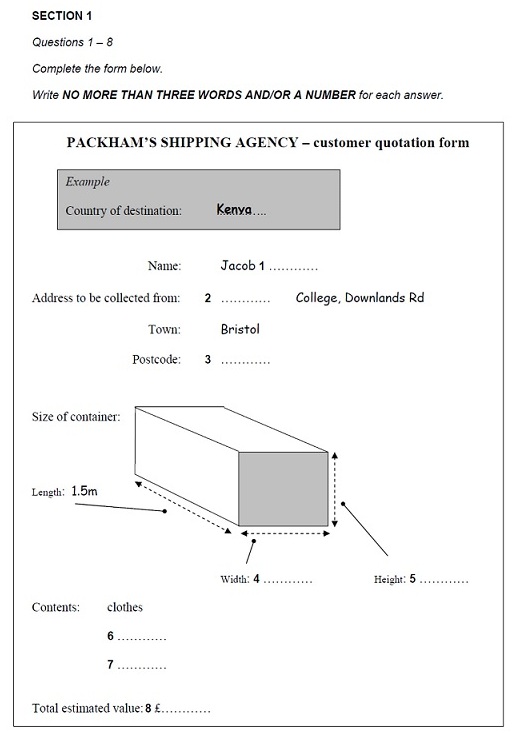
Source: Official IELTS website www.ieltsessential.com
The recording for this sample question is a
telephone conversation between a customer and an agent at a company which ships
large boxes overseas.
I’m going to use this second example to teach you the answer strategy and give you tips and advice on how to overcome the challenges presented by this type of question.
Strategy & Tips
You will have a short time to prepare before the speakers begin talking. Use this time to familiarise yourself with the question and focus your mind on what you need to listen out for.
1) Read the instructions
Read the instruction carefully, paying particular attention to how many words you are allowed to write for the answer.
The instructions for our sample question state that you must,
Write NO MORE THAN THREE WORDS AND/OR A NUMBER for each answer.
If you write more than three words, your answer will be marked incorrect even if the information you give is correct. Don’t lose marks over silly mistakes like this.
2) Look for a title
Not every question will have a title but if there is one, it will tell you the context of the question. Our sample question has the title ‘PACKHAM’S SHIPPING AGENCY – customer quotation form’.
Knowing the context gives meaning to the information in the notes. This will help you to understand the question and give you a big clue as to what sort of information will be contained in the recording.
3) Predict
the answers
Try to predict what the answers might be. This will focus your mind on what to listen out for in the recording.
Occasionally, you’ll be able to predict the actual word but mostly it’s one of these things that you’ll be able to determine:
- The type of information required, e.g. surname, place name, date, phone number, postcode, percentage, price.
- The type of word required, e.g. noun, adjective, verb.
The answers to form completion questions will usually be factual information such as that listed in the first bullet point above.
Any clues you can get will help you to understand the recording and identify the information needed for the answers.
Have a go at predicting some of the answers in our form completion practice question. There are 8 answers to fill in. Then have a look at my predictions below.
Here is the form again.
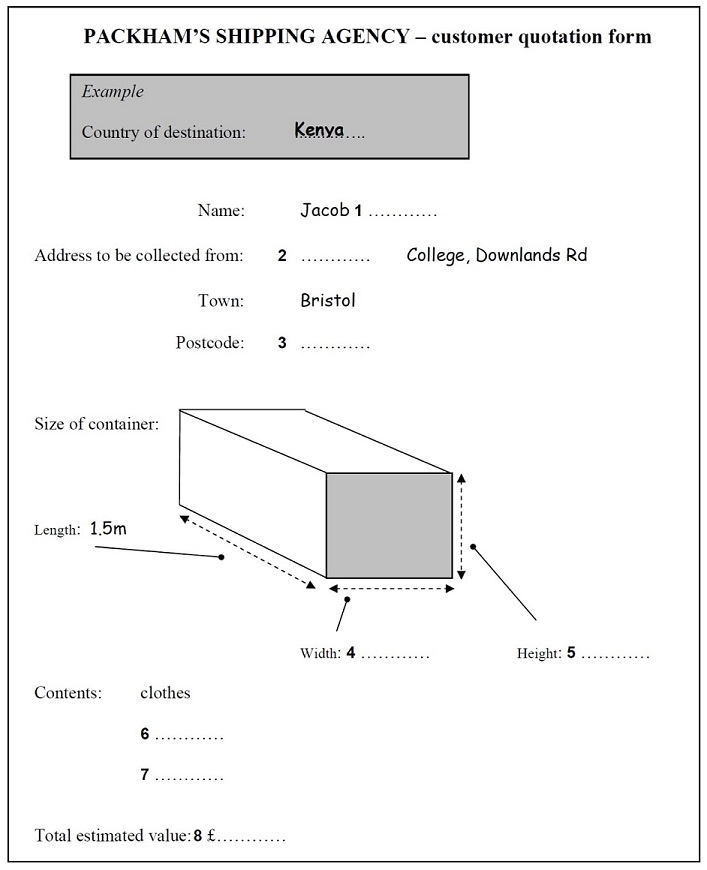
Predictions:
1 – a surname
2 – the college name
3 – a postcode made up of letters and numbers
4 & 5 – numbers of measurement
6 & 7 – nouns (items in the box)
8 – numbers written as a price
Answers 1 and 2 will be
proper nouns so, the first letter of each word must be a capital. If you don’t use
capitals, your answer will be marked wrong.
If you're concerned that you'll forget, write all your answers for the Listening test in capital letters.
4) Problematic vocabulary
There are 6 types of vocabulary that can cause particular problems for students and some of them will definitely be present in form completion questions, as we've just seen. The 6 types are:
- Time
- Numbers
- Prices
- Dates
- Letters
- Addresses
You must be able to recognise them in speech and to write them correctly in your answers.
I’ve written a whole lesson on this topic, including 8 listening exercises to help you recognise & learn these types of vocabulary. Follow this link to the lesson: Vocabulary Lesson & Exercises
5) Synonyms and paraphrasing
In all types of Listening questions, you need to listen out for synonyms and paraphrasing. These are something else that you may be able to predict.
If you have time before the recording starts, scan the question to identify key words or phrases that are likely to be replaced by synonyms and think of some that might be used. For example, the word ‘box’ might be used instead of ‘container’.
As you’re listening to the recording, remind yourself that you are not only looking for the exact words as are used in the question but words and phrases that have the same meaning.
We’ll look at some synonyms that have been used in this question when we review the answers
6) Watch out for distractors
The examiners will try and catch you out with distractors. A distractor is a word or a phrase that changes or corrects the original piece of information given. So, you may be given an answer and then have it taken away again.
Here are some sample sentences containing distractors. I’ve highlighted the relevant words.
- I really like the blue blouse but I think I’ll go for the red one as it will match my skirt better.
- The package contains clothes, toys and five books. However, I’ll take out the books if their weight makes shipping too expensive.
- I’d like to order two, please. No, wait a minute. I’ll have three so that I can give one to my mum as well as my sister.
‘But’ and ‘however’ are particularly common distractors but there are many different words and phrases that can be used to change or correct a piece of information so be alert for them.
7) Answer order
The answers will come in the same order in the recording as they are listed in the question so, you will hear answer 1 first, then answer 2 and so on. This makes it easier to pick out the answers than if they were in a random order.
8) Guess if necessary
My final tip is to never leave a blank space on the answer sheet. If you miss an answer, take an educated guess. This gives you at least some chance of getting it right. Don’t stress about a missed answer or it will affect your ability to answer the next set of questions. Just make your choice and move on.
Practice Activity
It’s now time for you to practice using this strategy on our
sample question. Here it is again.
Sample form completion question

Listen to the recording and answer the question. Refer back to the strategy as you need to and keep the predictions in mind. When you’ve completed the practice activity, go through the answers below.
Answers
Here are the correct answers. The words in brackets are optional – they are correct, but not necessary.
Answers:
1 Mkere
2 Westall
3 BS8 9PU
4 These 3 variations are acceptable:
- 0.75 m/metre(s)/meter(s) (wide)
- ¾ m (wide)
- 75 cm(s) (wide)
5 These 4 variations are acceptable:
- 0.5 m/metre(s)/meter(s) (high/deep)
- half metre/meter (high/deep)
- ½ m (high/deep)
- 50 cm(s) (high/deep)
6 & 7 These 2 answers can be written in either order:
- (some) books
- (some) toys
8 1,700
We’ll now look at them in
context and examine the language that has been used.
Answer 1: Mkere
Here’s the section of dialogue this answer appears in:
A Can I take your name?
B It’s Jacob Mkere.
A Can you spell your surname, please?
B Yes, it’s M-K-E-R-E.
It’s common in the IELTS
Listening test to hear names spelt out. This is to test your knowledge
of the different letter sounds, so make sure that you know them.
Pay particular attention to letters that sound similar when spoken, for example,
- Letters with an ‘ee’ sound – B, C, D, E, G, P, T, V
- Letters with an ‘ay’ sound – A, J, K
- M and N also sound very similar.
Answer 2: Westall
Here’s the section of dialogue this answer appears in:
A And where would you like the box picked up from?
B From college, if possible.
A Yes, of course. I’ll take down the address now.
B It’s Westall College.
A Is that W-E-S-T-A-L-L?
The answer is again spelt out and synonyms have also been used.
And where would you like the box picked up from? à Address to be collected from
In the dialogue, the company agent asks where the box should be picked up from. In the diagram the 'box' is labelled as a container.
Answer 3: BS8 9PU
Here’s the section of dialogue this answer appears in:
A Oh yes, I know it. And the postcode?
B It’s BS8 9PU.
For this answer, there are more letters to listen for and also numbers.
For form completion questions, you need to understand how addresses are written. British and Australian addresses are the most likely address formats to be used, although you could get a US address.
Here are examples of all three:
UK
5 Springfield Road
Taunton
Somerset
TA2 6JS
Australia
Unit 12
834 Benambra Street
Hinnomunjie Victoria 3898
USA
Apartment 1c
217 Berwick Avenue
Boston, MA 02130
You must use capital letters for the letters in a postcode. Also, make sure that you can spell common words such as ‘road’, ‘street’ and ‘avenue’.
Answer 4: Any of these 3 variations are acceptable:
- 0.75 m/metre(s)/meter(s) (wide)
- ¾ m (wide)
- 75 cm(s) (wide)
Here’s the section of dialogue this answer appears in:
A Right ... and I need to know the size.
B Yes, I’ve measured it carefully and it’s 1.5m long ...
A Right.
B 0.75m wide ...
They
have tried to catch you out by changing the form of some key words in this
question and the next question from the adjective form to the noun form.
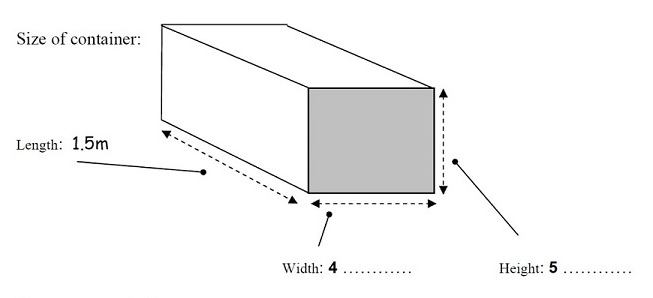
- long (adjective) à length (noun)
- wide (adjective) à width (noun)
- high / deep
(adjective) à height / depth (noun)
It can be useful to learn some common proportions, for example,
- 0.25 à ¼ à a quarter
- 0.50 à ½ à a half
- 0.75 à ¾ à three quarters
These will be useful in several parts of your IELTS test. Proportions are one variation of the answer you could give for this question.
Answer 5: Any of these 4 variations are acceptable:
- 0.5 m/metre(s)/meter(s) (high/deep)
- half metre/meter (high/deep)
- ½ m (high/deep)
- 50 cm(s) (high/deep)
Here’s the sentence this answer appears in:
B And it’s 0.5m high or deep.
We discussed this language in the previous answer.
Answer 6 & 7: These 2 answers can be written in either order:
- (some) books
- (some) toys
Here’s the section of dialogue they appear in:
A Can you tell me, you know, very generally, what will be in the box?
B Yes, there’s mostly clothes.
A OK.
B And there’s some books.
A OK. Good. Um ... Anything else?
B Yes, there’s also some toys.
This question
uses a synonym:
What will be in the box? à contents
Answer 8: 1,700
Here’s the section of dialogue this answer appears in:
A OK and what is the total value, do you think, of the contents?
B Well the main costs are the clothes and the books – they’ll be about £1500 but then the toys are about another two hundred – so I’d put down £1700.
Again, a
synonym has been used:
cost à value
Recordings often include discussion of the cost or price of things. You’re most likely to hear the price expressed as dollars ($), pounds (£) or euros (€). Learn these symbols and know how to write the amounts.
There’s lots of help with these, including practice exercises, in the lesson mentioned above. Here’s the link again: Vocabulary Lesson & Exercises
If you got any of the answers wrong, listen to the recording again and see if you can pick them out now that you’re more familiar with the text.
I hope you’ve found this lesson helpful. Now practice using this strategy with other form completion questions from past papers. It’s only with practice that your skills will improve and you’ll get the score you need in your IELTS Listening test.
You'll find lessons on how to answer other types of Listening questions in the menu below.
Want to watch & listen to this lesson?
Click on this video.
Like this page?
IELTS Listening – All Lessons
IELTS Listening Test – Understand the format & question types. Know what skills are assessed. Also, discover 3 important marking tips.
Listening Strategies – Learn 3 essential listening strategies – question analysis, answer prediction & how to use keyword clues.
Listening Skills – Learn the 4 key listening skills needed for a high score highly. Examples from real questions.
Listening Exercises – 8 listening exercises to help you recognise & learn vocabulary for 6 common topics – time, numbers, prices, dates, letter names & addresses.
The 10 Question Types – Examples of all 10 types of Listening questions. Learn how to recognise & understand them. Links to 10 step-by-step lessons.
Listening Tips – Top 10 tips to bring you success in your Listening test. Essential information you need to know to achieve a high score.
How to Improve Your Listening Skills – 6 simple strategies essential for achieving a high score in the test.
Listening Practice – 4 practice techniques to develop your listening skills
Map & Plan Vocabulary – Learn the vocabulary you need for your test. 5 maps & plans with sample sentences containing common vocabulary of location & direction.
Listening Practice Samples – Short activities to improve your listening skills & help you learn topic vocabulary.
Genuine Full Practice Tests:
The 10 Question Types
Click the links below to learn how to answer each type of question.



